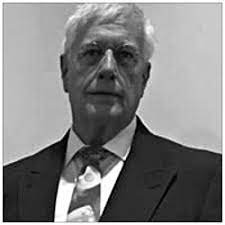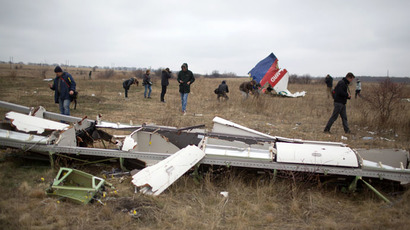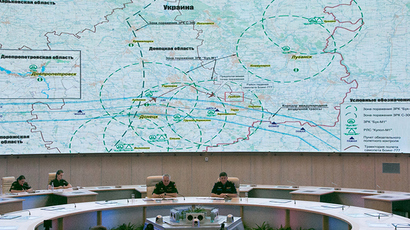“One of the things we settled on early on is that in the middle of the day if this were a Buk missile, the contrail would have been seen for 50 miles [80km].
The contrail itself would have been photographed by thousands of people; it would have been on Instagram, on Twitter, it would have been all over YouTube – and no one saw it. You can’t fire a missile on a flat area in the middle of the day leaving a smoke trail into the air and having everyone not see it,” Duff said.
“There is no reliable information supporting that it was a Buk missile fired by anyone,” he added. (March 2, 2015, during a live broadcast on RT/Moscow)
Sputnik/Moscow: Leaked papers pertaining to the finalized JIT investigation that the source has bona fide reason to believe are authentic do not corroborate the study’s findings. They cite witness testimonies as well as a number of discrepancies in the probe that suggest the Boeing was downed by an air-to-air missile, rather than a surface-to-air rocket.
According to new data from unpublished MH17 Joint Investigation Team documents obtained and analyzed by Bonanza Media investigative journalist Max van der Werff, there were no Buk missile systems in the vicinity of where the Malaysian Airlines Boeing crashed in eastern Ukraine on 17 July 2014.
The journalist concludes, citing a letter from Dutch Military Intelligence, that it “becomes apparent that flight MH17 was flying beyond the range of all identified and operational Ukrainian and Russian locations where 9K37M1 Buk M1 systems were deployed”.
The letter, dated 21 September 2016, which is exactly one week before JIT held a press conference on 28 September, proves the Dutch team obtained evidence that no Russian Buk system had crossed into Ukraine from Russia only days before the presser, der Werff wrote.
Fighter Jets ‘Audible’
Another leak studied by the journalist is the text of an interview conducted by a Dutch police officer on 28 July 2015 with a male witness from Ukraine, as well as the man’s in-depth email where he described the timeline of events.
He reportedly recalled two fighter jets in the sky circling over the town a few minutes before the Boeing 777 went down following a loud bang over his head and a horizontal white trail penetrating the sky.
“Two airplanes were audible, not the big one, the Boeing, but fighter jets were audible since these were constantly flying overhead, the noise had already become familiar”, he is quoted by der Werff as saying.
According to the resident of the Torez suburbs, roughly 20 kilometers from Hrabove, where the Boeing crashed, no missiles were fired from the ground in the immediate vicinity.
Separately, he assumed the earlier circulated photos of the incident contain inconsistencies.
“This photograph that served as evidence of the missile is erroneous since the photograph showed different weather conditions”, the man explained, adding:
“Because at that time the sky was rather heavily overcast. The position of the Sun in that photograph is unlike the Sun you see at 17:00 hrs”.
Image Metadata Altered?
Then there is another leak suggesting that roughly a year after the crash, between 22 April 2015 and 2 July 2015, imagery specialist Shaun Ellis and geospatial analyst Tim Johns from Australia were still examining the circulated non-primary images dated around the time of the crash and first published by Paris Match.
As part of the so-dubbed Operation AVENELLA, they reportedly concluded that the metadata from these files “appears to have been manipulated. For example, the date modified is prior to the date the file was created”, something that the pros believe is not accidental.
Three of the four analysed images were found to have been antedated: so that the day of creation fell after, not before the modification date.
“Various reasons could explain why this is so, none can be proved without additional information”, Max van der Werff concludes, adding separately that the image dimensions vary, suggesting the images could have been cropped, or intentionally resaved in a smaller format.
More Witness Data
The last but not least leak is a “Record Of Interview” (ROI) between an officer from the Australian Federal Police and German journalist Billy Six. In the shorthand report, Six talks among other things, about those witnesses that saw Ukrainian fighter jets in the sky on the day of the MH17’s demise. Max van der Werff asserted he knows his colleague Six in person.
“The latter confirmed to me he was interviewed a day before the Dutch Safety Board held a press conference on 13 October 2015″, der Werff wrote noting this information matches the transcript mentioning 12 October 2015 as the date of the ROI. The journalist said this is “a strong indication that the batch of JIT documents leaked to us is authentic”. He, however, refused to specify the source who had provided him with the JIT documents.
Dutch-Led Five-Year MH17 Probe
Malaysian Airlines Flight MH17 was en route from Amsterdam to Kuala Lumpur when it was downed over eastern Ukraine on 17 July 2014 as the region was mired in a conflict with the new Ukrainian government set up after a coup in Kiev earlier that year. As a result, all 298 passengers – largely Dutch – and crew on board were killed in the crash.
Kiev and the self-proclaimed republics in the east of the country blamed each other for the downing, with the republics contending that the military equipment they had at their disposal would not allow them to shoot down an aircraft at that altitude. The US and a number of European nations blamed the incident on Russia, a claim that was made even before an official investigation was launched, with the West repeatedly citing Russia being at odds with Ukraine over Crimea and Donbass.
A Joint Investigative Team (JIT) consisting of Australia, Belgium, Malaysia, the Netherlands, and Ukraine was set up to probe the MH17 case, but Russia was left out of the process despite the latter’s offers of assistance and readiness to help investigate the incident.
The JIT probe concluded last year that the aircraft was downed by a Buk missile, purportedly launched from a Russian anti-aircraft missile brigade stationed in the city of Kursk, not far from the Ukrainian border.
However, no concrete evidence has hitherto been provided as proof, with the Russian side dissatisfied by the Netherlands’ unwillingness to make use of Russia’s domestic investigation results.
Three Russian nationals were charged with murder – Igor Girkin, Sergei Dubinsky, and Oleg Pulato. One Ukrainian, Leonid Kharchenko has also been charged, with a trial scheduled for 9 March.*
March 2, 2015, for VT and Russia Today
As the investigation into the MH17 tragedy continues in eastern Ukraine, the SU-25’s chief designer has told German media that the fighter jet could not possibly have taken down the passenger plane. RT spoke to former pilots about the jet’s capabilities.
Malaysia Airlines flight MH17, en route from Amsterdam to Kuala Lumpur, crashed down over rebel-held eastern Ukraine on July 17, 2014. Everyone on board – 283 passengers and 15 crew members – perished in the tragedy.
A report on the official investigation published in September 2014 said the crash was a result of structural damage caused by a large number of high-energy objects that struck the Boeing from the outside. However, it did not conclude what the objects were, where they came from, or who was responsible.
Kiev and some Western states have placed blame on eastern Ukraine militias and Russia. The Russian Defense Ministry shared radar data pointing to other possibilities in July – including an attack by a Ukrainian Sukhoi-25 fighter jet, which was said to have been tracking the passenger plane.
While an official international investigation into the crash has been dragging on for nine months, the debate into the cause of the tragedy has been once again reignited by recent comments from the chief designer of the SU-25.
READ MORE: MH17 broke up in mid-air due to external damage – Dutch preliminary report
Kiev-born Soviet and Russian aircraft designer Vladimir Babak said on Monday that the SU-25 jet – which was spotted tracking the MH17 Boeing at the moment it crashed down – did not have the capability to shoot down a passenger plane. He said the fighter jet could have successfully attacked the Boeing at an altitude of 3,000-4,000 meters, but not at the plane’s altitude of 10,500 meters. He added that air-to-air missiles would have only damaged the Boeing – not completely destroyed it while still in the air.

“I believe all allegations that a SU-25 could be involved in this tragedy are a cover-up attempt,” Babak said in an interview to German channels NDR and WDR. “I cannot explain it otherwise. We cannot understand how a SU-25 could take down the Boeing.”
‘SU-25 capable of high altitude flights, can carry powerful missiles’
However, several former top officials and SU-25 pilots disagree with Babak.
Based on the analysis of the plane debris and the nature of the damage, there is a high probability the plane was struck by an air-to-air missile and an aircraft gun, Lieutenant General Aleksandr Maslov, former deputy chief of the Russian Air Defense and Land Forces, told RT.
“The published photos [from the MH17 crash site] enable us to assume that the Boeing was downed by a military jet. Besides that, the existing damage indicates that the airplane was shot with air-to-air missiles together with an aircraft gun with a 30mm caliber,” Maslov said.
Claims that the passenger plane was downed by a surface-to-air Buk missile “cannot be supported,” as the nature of the damage from the missiles is different, he added.
Commenting on the jet’s ability to maneuver at higher altitudes, the former commander of an aviation division, Major General Sergey Borysyuk, noted that the jet would have had the capability to “maneuver comfortably,” even at such a high altitude.
“I personally flew, and not once, at an altitude of 12,000 meters…,” he said. “My colleagues have risen to an altitude of 14,000 meters. The altitude of 10,500 was officially authorized during operations in Afghanistan. Therefore the plane, even at an altitude of 12,000 meters, has the capability to maneuver comfortably, its aerodynamic characteristics enable it to do so.”
Borysyuk explained that the R-60 missiles on the SU-25 have an infrared homing and a rod warhead. Citing the nature of the plane’s debris and the “precisely sliced fuselage,” he said that R-60 missiles were possibly used.
“The firing range of the missile is 7.5km. And in those conditions, the probability of hitting the target increases,” he added.
The former chief commander of Russia’s Air Force, Vladimir Mikhailov, also said he flew the SU-25, reaching an altitude of 12,000 meters and even 14,000 meters. He also stated that the plane “comfortably maneuvers” at such heights.
“If the plane was downed by Buk [missile defense system], it would have almost immediately fallen to pieces in the air and we could not have witnessed such large debris on the ground,” he said.
Along with Russia’s Ministry of Defense, he also questioned why the MH17 flight stayed within the flying corridor until it reached Donetsk, but then deviated from the route to the north.
In July 2014, Russia’s Ministry of Defense presented military monitoring data which showed Kiev military jets tracking MH17 shortly before the crash and posed a set of questions to Ukraine over the circumstances of the tragedy, which have still not been answered.
‘You can’t fire Buk missile in broad daylight with no witnesses’
Speculation about the combat capabilities of the SU-25 jet stem from the Russian definition of the aircraft’s service ceiling – which is not the same as its absolute ceiling, as defined by the US military, VT senior editor Gordon Duff told RT.
“The claimed service ceiling is based on the oxygen supply in the aircraft. Now, there is a claim that this plane [SU-25] will only work to 22,000 feet. At the end of World War II, a German ME-262 would fly at 40,000 feet, a P-51 Mustang propeller plane flew at 44,000 feet. The SU-25 was developed as an analog of the A-10 Thunderbolt, an American attack plane. The planes have almost identical performance, except that the SU-25 is faster and more powerful. The A-10 Thunderbolt has a service ceiling of 45,000 feet. The US estimates the absolute ceiling, which is a different term,” Duff explained.
The known estimate for the absolute ceiling of the SU-25 is 52,000 feet (15.8km), he added.
Moreover, Duff said one cannot be entirely sure the detected fighter jet was a SU-25 at all, as modern radar spoofing counter-measures – such as those designed by BAE Systems and employed by NATO – are able to mask any other aircraft, be it a SU-27 or F-15, as another plane.
Duff said he also discussed the possibility of the MH17 flight having been shot by a ground-to-air missile with experts from the FAA (Federal Aviation Administration), the FBI, the Air Line Pilots Association, as well as air traffic and air operational officers – and they all agreed that no proof of anti-aircraft missile use has been provided to the public.
It is highly unlikely that the launch of such a missile would have gone unnoticed in the area, Duff stressed, adding that the trail left by the rocket in the air would have been witnessed and filmed by “thousands.”
“One of the things we settled on early on is that in the middle of the day, if this were a Buk missile, the contrail would have been seen for 50 miles [80km]. The contrail itself would have been photographed by thousands of people; it would have been on Instagram, on Twitter, it would have been all over YouTube – and no one saw it. You can’t fire a missile on a flat area in the middle of the day leaving a smoke trail into the air and having everyone not see it,” Duff said.
“There is no reliable information supporting that it was a Buk missile fired by anyone,” he added.

Gordon Duff posted articles on VT from 2008 to 2022. He is a Marine combat veteran of the Vietnam War. A disabled veteran, he worked on veterans and POW issues for decades.
Gordon is an accredited diplomat and is generally accepted as one of the top global intelligence specialists. He manages the world’s largest private intelligence organization and regularly consults with governments challenged by security issues.
Duff has traveled extensively, is published around the world, and is a regular guest on TV and radio in more than “several” countries. He is also a trained chef, wine enthusiast, avid motorcyclist, and gunsmith specializing in historical weapons and restoration. Business experience and interests are in energy and defense technology.
ATTENTION READERS
We See The World From All Sides and Want YOU To Be Fully InformedIn fact, intentional disinformation is a disgraceful scourge in media today. So to assuage any possible errant incorrect information posted herein, we strongly encourage you to seek corroboration from other non-VT sources before forming an educated opinion.
About VT - Policies & Disclosures - Comment Policy







So, the shelved report by the once respected BBC was right after all. Eyewitnesses saw warplanes in the sky at the time MH17 came down. My guess is that Ukrainian/Israeli jets shot it down mistaking it for Putin’s flight. The BUK missile yarn was the prepared cover story for Putin’s assassination.
What a botch job – if this was a real investigation by the JIT it could be classed with the ones in the waste-paper basket. Digital material is manipulated or of uncertain provenance, so unprofessional. But of course it’s a cover-up so what do we expect? Not much.
Comments are closed.